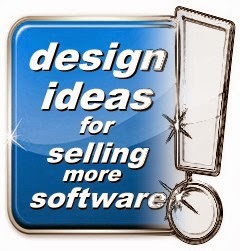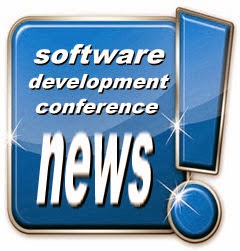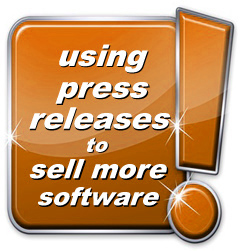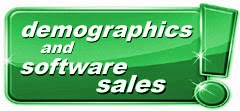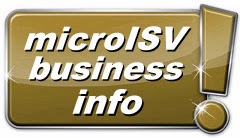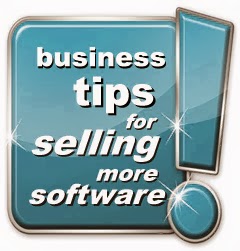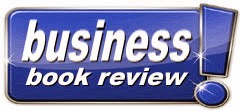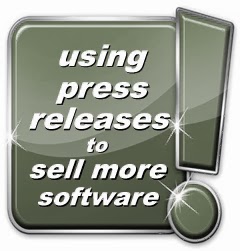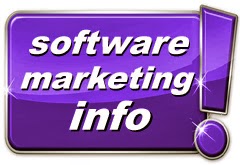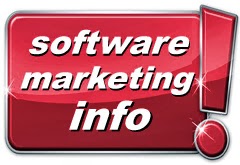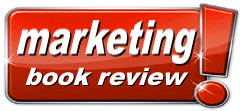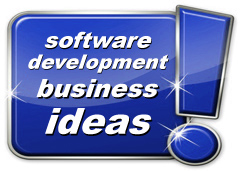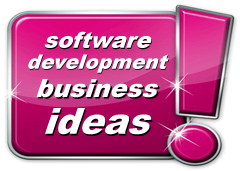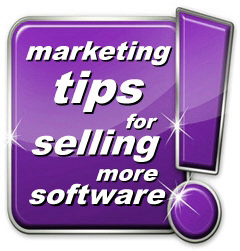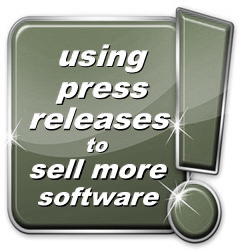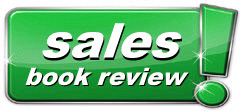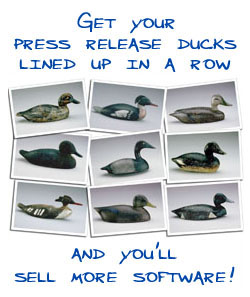It's good software marketing to mention great reviews that you've received from well-respected download sites. Many of today's editors know that a high rating from some of the minor download sites doesn't mean much. But good ratings from the top download sites are worth mentioning.
Be careful, though, when citing the reviews that you've gotten from magazines and newspapers. If your press release mentions a good review from a publication that is a direct competitor to the one that's considering printing your news release, they might not be interested in supporting you and validating their competitor's judgment.
News releases are a cost-effective way to market more software.
Your competitors are using news releases to promote their smartphone and computer software. So should you! Contact DP Directory, and start getting your share of free publicity from bloggers, newspapers, and magazines.
Software marketing ideas from Al Harberg,
the Software Marketing Glossary guy from DP Directory, Inc.
Monday, December 30, 2013
Friday, December 27, 2013
Graying of America 101 for microISVs
Demographics are important. If America is graying, and you're selling software to Americans, then you need to be aware of this demographic change.
Kenneth Gronbach talks about the myth of the Graying of America in his 2008 book "The Age Curve - How to Profit from the Coming Demographic Storm." He believes that the assisted-living industry has listened to the myth, and as a result has seriously overbuilt in anticipation of a need that won't arrive for another 20 years or so.
Gronbach asks where this unusually large number of old people will come from -
Sure, software developers need to pay attention to demographics when deciding which applications to develop and market. But there is still a long, long time to plan for a huge marketplace for software to support the elderly.
Kenneth Gronbach talks about the myth of the Graying of America in his 2008 book "The Age Curve - How to Profit from the Coming Demographic Storm." He believes that the assisted-living industry has listened to the myth, and as a result has seriously overbuilt in anticipation of a need that won't arrive for another 20 years or so.
Gronbach asks where this unusually large number of old people will come from -
- It can't be from the GI Generation (born 1905 through 1924) because most of these 75 million folks have passed away.
- It can't be from the Silent Generation (born 1925 through 1944) because there are nine million fewer of them than there were GI Generation folks.
- It can't be from the Baby Boomer Generation (born 1945 through 1964) because they're not in need of services for the elderly, and won't be for quite some time.
Sure, software developers need to pay attention to demographics when deciding which applications to develop and market. But there is still a long, long time to plan for a huge marketplace for software to support the elderly.
Thursday, December 19, 2013
GUI Advice from Seth Godin
"Digital metaphor is the enemy of progress," Seth Godin tells us. In fact, Godin devotes a chapter in his book "The Big Red Fez - How to make any web site better" to discouraging website designers from introducing digital metaphors into their website designs.
Make it simple for prospects and customers to navigate your website, Godin urges. Don't give them puzzles to solve, or metaphors to figure out.
This is strange advice, I might point out, from an author who uses monkey, banana, and pachinko machine metaphors at the heart of his "The Big Red Fez" book.
Perhaps better advice for website designers might be to capitalize on the metaphors that are widely accepted on the web such as shopping cart images, RSS-feed symbols, and cloud icons. People understand what these concepts mean, and it would be counterproductive to introduce new metaphors when intuitive metaphors are already part of the Internet culture.
My advice would be to avoid any wording, images, or metaphors that detract from the sales process. Entertaining your website visitors is a secondary goal. Concentrate on delivering a clear, easy-to-understand sales message about the benefits of your software applications.
Make it simple for prospects and customers to navigate your website, Godin urges. Don't give them puzzles to solve, or metaphors to figure out.
This is strange advice, I might point out, from an author who uses monkey, banana, and pachinko machine metaphors at the heart of his "The Big Red Fez" book.
Perhaps better advice for website designers might be to capitalize on the metaphors that are widely accepted on the web such as shopping cart images, RSS-feed symbols, and cloud icons. People understand what these concepts mean, and it would be counterproductive to introduce new metaphors when intuitive metaphors are already part of the Internet culture.
My advice would be to avoid any wording, images, or metaphors that detract from the sales process. Entertaining your website visitors is a secondary goal. Concentrate on delivering a clear, easy-to-understand sales message about the benefits of your software applications.
Labels:
digital metaphor,
graphical user interface,
GUI,
metaphors
Monday, December 16, 2013
Cash in on Security Applications
The worldwide marketplace for security technology - including security software - will go up 8.7 percent in 2013 to $67.2 billion US dollars. So says Gartner, as reported in a recent issue of Processor Magazine.
By 2016, Gartner predicts that worldwide spending on security technology will increase to $86 billion.
Gartner names three security concerns that will keep spending high in the coming years -
microISVs who have a background in security technology should consider developing software for this growing market. Software developers with no plans to develop security applications should give serious thought to weaving the concept of security into the sales messages of every application that they offer.
With so many business and home technology consumers concerned about security issues, it makes sense to design significant security features into all of your current and future application programs, and to talk about the software's security features and benefits in all of its sales presentations.
By 2016, Gartner predicts that worldwide spending on security technology will increase to $86 billion.
Gartner names three security concerns that will keep spending high in the coming years -
- Mobile security, fueled by the bring your own device (BYOD) trend that is sweeping the world,
- Big Data security, and
- Advanced attacks against the current technology that has been designed to protect privacy and security.
microISVs who have a background in security technology should consider developing software for this growing market. Software developers with no plans to develop security applications should give serious thought to weaving the concept of security into the sales messages of every application that they offer.
With so many business and home technology consumers concerned about security issues, it makes sense to design significant security features into all of your current and future application programs, and to talk about the software's security features and benefits in all of its sales presentations.
Wednesday, December 11, 2013
Write Stronger Sales Presentations
Book review of Direct Mail Copy That Sells! by Herschell Gordon Lewis (published 1984 by Prentice-Hall, Inc.).
Learn to write sales messages from a Hall of Fame copywriter, and you'll sell more of your software applications.
Herschell Gordon Lewis has been a respected direct-mail consultant since the early 1970s. In the summer of 2003, he was inducted into the Direct Marketing Association's Hall of Fame. "Direct Mail Copy That Sells!" contains tons of advice that can help software developers write website copy, whitepapers, eBooks, blog postings, PAD files, and news releases.
Lewis says, "When you emphasize everything, you emphasize nothing. A laundry list of '147 reasons why you should buy now' is weaker than one powerhouse reason, reinforced by ancillary reasons."
The author also says, "Tell the reader or viewer what to do. Subtlety doesn't work....Don't just describe. Get the order."
The book contains four Laws of advertising copy, and 12 rules to save your copy's life - and that's in the first 14 pages of "Direct Mail Copy That Sells!."
Lewis would probably cry openly if he read the dry lists of features that so many software developers use to entice prospects to buy their application programs. "Replace intellectual words with emotional words," Lewis tells us, "and you'll sell more because you'll trigger an emotional response." That sounds like good software marketing advice to me.
Lewis urges writers to abandon the technical jargon, and to "write within the experiential background of the reader, not yourself."
Today it's fashionable to buy the latest books on writing effective sales copy. This can be a mistake. The web didn't change how people are persuaded to spend their money. Increased software sales won't flow from books with titles like "Wayne and Garth's Most Excellent Internet Sales Words Guide".
We would all benefit by going back to basics and learning from accomplished copywriters. Herschell Gordon Lewis can teach us to write better. "Direct Mail Copy That Sells!" is a quick read, and an excellent reference book. It will strengthen your software marketing.
Learn to write sales messages from a Hall of Fame copywriter, and you'll sell more of your software applications.
Herschell Gordon Lewis has been a respected direct-mail consultant since the early 1970s. In the summer of 2003, he was inducted into the Direct Marketing Association's Hall of Fame. "Direct Mail Copy That Sells!" contains tons of advice that can help software developers write website copy, whitepapers, eBooks, blog postings, PAD files, and news releases.
Lewis says, "When you emphasize everything, you emphasize nothing. A laundry list of '147 reasons why you should buy now' is weaker than one powerhouse reason, reinforced by ancillary reasons."
The author also says, "Tell the reader or viewer what to do. Subtlety doesn't work....Don't just describe. Get the order."
The book contains four Laws of advertising copy, and 12 rules to save your copy's life - and that's in the first 14 pages of "Direct Mail Copy That Sells!."
Lewis would probably cry openly if he read the dry lists of features that so many software developers use to entice prospects to buy their application programs. "Replace intellectual words with emotional words," Lewis tells us, "and you'll sell more because you'll trigger an emotional response." That sounds like good software marketing advice to me.
Lewis urges writers to abandon the technical jargon, and to "write within the experiential background of the reader, not yourself."
Today it's fashionable to buy the latest books on writing effective sales copy. This can be a mistake. The web didn't change how people are persuaded to spend their money. Increased software sales won't flow from books with titles like "Wayne and Garth's Most Excellent Internet Sales Words Guide".
We would all benefit by going back to basics and learning from accomplished copywriters. Herschell Gordon Lewis can teach us to write better. "Direct Mail Copy That Sells!" is a quick read, and an excellent reference book. It will strengthen your software marketing.
Monday, December 9, 2013
Don't Say "shareware" in your Press Release
Don't use the term "shareware" when marketing your software.
Perhaps include the word "shareware" - one time only - on your website, in case somebody types it into their favorite search engine when looking for an application like yours. The term "shareware" can be a confusing or negative word to many prospects. And it can be a serious turn-off to corporate buyers.
It's okay to say that you have a free trial version of your software that prospects can download. But don't call it "shareware."
Magazines and newspapers rely upon subscription income, advertising income, and various methods of monetizing their online sites. Magazine and newspaper publishers define a "shareware author" as somebody who doesn't buy advertising. Given two high-quality news releases, one for a shareware product and one for a shrink-wrapped shelfware product, it benefits the magazine or newspaper to print the shelfware press release because the shelfware publisher is more likely to become an advertiser.
It's true that most publications have a brick wall between their editorial and advertising departments. But you simply don't help yourself get publicity by describing your software as "shareware".
Press releases make your application memorable.
The biggest cost of a news release campaign could the lost opportunity cost. Don't use a part-time press release emailing company with an amateurish list compiled from the Internet. DP Directory has the best, most current lists in the software industry. We also have vertical market lists such as business, education, music, video, and many others. Contact DP Directory today about your press release writing and submission.
Perhaps include the word "shareware" - one time only - on your website, in case somebody types it into their favorite search engine when looking for an application like yours. The term "shareware" can be a confusing or negative word to many prospects. And it can be a serious turn-off to corporate buyers.
It's okay to say that you have a free trial version of your software that prospects can download. But don't call it "shareware."
Magazines and newspapers rely upon subscription income, advertising income, and various methods of monetizing their online sites. Magazine and newspaper publishers define a "shareware author" as somebody who doesn't buy advertising. Given two high-quality news releases, one for a shareware product and one for a shrink-wrapped shelfware product, it benefits the magazine or newspaper to print the shelfware press release because the shelfware publisher is more likely to become an advertiser.
It's true that most publications have a brick wall between their editorial and advertising departments. But you simply don't help yourself get publicity by describing your software as "shareware".
Press releases make your application memorable.
The biggest cost of a news release campaign could the lost opportunity cost. Don't use a part-time press release emailing company with an amateurish list compiled from the Internet. DP Directory has the best, most current lists in the software industry. We also have vertical market lists such as business, education, music, video, and many others. Contact DP Directory today about your press release writing and submission.
Labels:
new release,
press release,
shareware,
software,
trial version
Friday, December 6, 2013
Dual-Core & Quad-Core Smartphones
In 2017, consumers will buy 1.5 billion smartphones. Most of these mobile devices will have quad-core processors, and almost all of the rest will have dual-core processors.
So says Berg Insight's forecast, as reported in a recent issue of Processor Magazine.
Dual-core processors made their way into smartphones for the first time in 2011. Quad-core processors were introduced in 2012. In the future, look for mobile devices to have the same powerful multi-core processors found in desktop and laptop PCs.
So says Berg Insight's forecast, as reported in a recent issue of Processor Magazine.
Dual-core processors made their way into smartphones for the first time in 2011. Quad-core processors were introduced in 2012. In the future, look for mobile devices to have the same powerful multi-core processors found in desktop and laptop PCs.
Wednesday, December 4, 2013
Listen to Disruptive People
Disruptive people are an asset.
Robert Lutz believes this statement so strongly that he dedicated an entire chapter to the topic in his book "Guts - The seven laws of business that made Chrysler the world's hottest car company."
Lutz tells us that disruptive people are agents of change.
He suggests that the best change agents are the ones who are irritating enough to set new things in motion, but not irritating enough to turn off the people who have to implement these changes.
If Lutz is correct, then those of us in the software development industry are blessed. There's certainly no shortage in our business of disruptive people. On a more serious note, I've found over the years that too many people tune out the ideas raised by disruptive people. A more productive strategy is to filter out the irritating way that some people express themselves, and concentrate on their ideas.
Robert Lutz believes this statement so strongly that he dedicated an entire chapter to the topic in his book "Guts - The seven laws of business that made Chrysler the world's hottest car company."
Lutz tells us that disruptive people are agents of change.
He suggests that the best change agents are the ones who are irritating enough to set new things in motion, but not irritating enough to turn off the people who have to implement these changes.
If Lutz is correct, then those of us in the software development industry are blessed. There's certainly no shortage in our business of disruptive people. On a more serious note, I've found over the years that too many people tune out the ideas raised by disruptive people. A more productive strategy is to filter out the irritating way that some people express themselves, and concentrate on their ideas.
Saturday, November 30, 2013
Tuxera NTFS for Mac wins the 2013
Epsilon Award for Software Excellence
Tuxera NTFS for Mac by Tuxera Inc. was named the winner of the 2013 Epsilon Award at the 13th annual European Software Conference. Each year, The Epsilon Award recognizes the best software application from the European independent software vendor (ISV) community.
The OS X operating system does not support writing to Microsoft Windows NTFS volumes. Tuxera fills this need with Tuxera NTFS for Mac, the fastest way to read and write Windows disks from Mac. Unlike other software that allows Macs to read and write Windows data, Tuxera NTFS for Mac employs a unique proprietary smart-caching technology that maximizes data transfer speeds, as it ensures data integrity.
Tuxera NTFS for Mac supports native extended attributes. The software automatically translates and converts file names to NTFS standards. Tuxera NTFS for Mac is fully compatible with third-party software including Parallels Desktop, VMWare Fusion, and TrueCrypt.
Tuxera NTFS for Mac works with the latest OS X Mavericks and every version of Mac OS X starting from 10.4 (Tiger). Intel and PowerPC Mac hardware systems are supported, as are all versions of NTFS. The software works in both 32-bit and 64-bit kernel modes.
A single-user license costs $31(US). Multi-user license discounts are available. For more information, visit www.tuxera.com/products/tuxera-ntfs-for-mac
The 14th annual European Software Conference will be held November 22nd and 23rd, 2014 in a location to be announced in March of 2014. Additional information about the Epsilon Award, and about the European Software Conference, can be found on www.euroconference.org
The OS X operating system does not support writing to Microsoft Windows NTFS volumes. Tuxera fills this need with Tuxera NTFS for Mac, the fastest way to read and write Windows disks from Mac. Unlike other software that allows Macs to read and write Windows data, Tuxera NTFS for Mac employs a unique proprietary smart-caching technology that maximizes data transfer speeds, as it ensures data integrity.
Tuxera NTFS for Mac supports native extended attributes. The software automatically translates and converts file names to NTFS standards. Tuxera NTFS for Mac is fully compatible with third-party software including Parallels Desktop, VMWare Fusion, and TrueCrypt.
Tuxera NTFS for Mac works with the latest OS X Mavericks and every version of Mac OS X starting from 10.4 (Tiger). Intel and PowerPC Mac hardware systems are supported, as are all versions of NTFS. The software works in both 32-bit and 64-bit kernel modes.
A single-user license costs $31(US). Multi-user license discounts are available. For more information, visit www.tuxera.com/products/tuxera-ntfs-for-mac
The 14th annual European Software Conference will be held November 22nd and 23rd, 2014 in a location to be announced in March of 2014. Additional information about the Epsilon Award, and about the European Software Conference, can be found on www.euroconference.org
Sunday, November 24, 2013
Closing Every Software Sale
Book review of How to Close Every Sale - Field-tested, can't-lose techniques to win lifetime customers - and make every sale stick! by Joe Girard (published 2002 by Warner Books).
This book about face-to-face selling can help microISVs sell desktop/laptop software, iPhone/Android apps, and software as a service (SaaS) on the Internet.
Joe Girard has been named "the world's greatest salesman" by The Guinness book of World Records. In a period of fifteen years, Girard sold 13,000 cars, with no fleet sales and no leases.
Unlike the majority of sales books that emphasize closing each sale, Girard points out that every salesperson has to create the need for his or her product or service. We must create the desire to own what we're selling. As Girard says, "The prospect must believe that your product has more value than his or her money."
Prospects don't like hard sell. Most people don't like dealing with an overbearing salesman or saleswoman. Software developers can learn from this advice. By making your website congenial and professional, you can convince prospects to make the software-buying decision, without resorting to hard sell tactics.
In addition to selling your software, Girard tells us, you have to sell yourself and sell your company. A professional website does a lot of this work on your behalf. In addition, your website has to convey both conviction and enthusiasm. Your prospects need to think that you're proud of your family of software applications, and that you believe that they're valuable.
"I don't have anything on my walls to confuse my customers," Girard tells us about his office. "There are no photographs of cars because I don't want a prospect to think about any other model except the one that I'm selling him. Nor is my desk cluttered with anything that might be distracting."
 Girard would probably advise developers to get rid of many of the distractions on their websites, too. Don't lose prospects by letting them click on links to your trade association, local weather forecast, or favorite sports team. Distracting prospects can damage your software marketing efforts. Keep them focused on the prize - on your software programs and the benefits that they'll enjoy when they own your software.
Girard would probably advise developers to get rid of many of the distractions on their websites, too. Don't lose prospects by letting them click on links to your trade association, local weather forecast, or favorite sports team. Distracting prospects can damage your software marketing efforts. Keep them focused on the prize - on your software programs and the benefits that they'll enjoy when they own your software.
Girard believes that more face-to-face sales are lost to procrastination than to any other problem. Many prospects are afraid to make decisions, and they'll say that they want to "think it over". The web turns your prospect's computer into a procrastination machine. Software developers have to convince prospects that now is the time for them to make the buying decision. Ask for the sale, and make it easy to people to order your software.
One of the closing techniques that Girard talks about in "How to Close Every Sale" is the Follow-the-Leader close. "Some prospects will buy only after they know that prominent people have signed up." On the Internet, this means that user testimonials can nudge prospects to become customers. Make it easy for prospects to find your endorsements and testimonials.
There's a fascinating chapter on the dangers of overselling. Girard admonishes us not to confuse prospects with too many details. You can overwhelm people, and lose the sale.
I don't think Joe Girard would be a fan of the shareware concept. When people tell him that they want to think about his proposal and talk to him in a few days, he always says, "I'm sorry but I don't make callbacks."
If Joe Girard can't sell you a car in a single sales presentation, he won't set up a second appointment to try again to close the sale. He's so good at selling, he'd rather work with a new prospect than meet with today's prospect a second time.
Imagine how Joe Girard would feel if he learned that there is an entire industry that turns down sales, and forces prospects to try before they buy. I'm sure he'd urge shareware authors to try to close every sale, and to use the "try before you buy" technique as a backup sales approach. But he would be amazed that there is an entire sales methodology based on telling people not to buy now.
The book contains advice on going for the big sale (in the world of microISV sales, this would be selling multi-user licenses or site licenses), saying "thank you," staying in touch with your customers, providing customer service, and doing all of the things that ensure both referrals and future sales.
To get the most value out of "How to Close Every Sale," you'll have to translate Joe Girard's advice about face-to-face sales into the marketplace of selling software over the Internet. But it's worth the work. Joe Girard is an enormously successful salesman, and most of his advice and techniques can help software developers increase sales of their applications.
The book is an easy read, and full of good ideas.
This book about face-to-face selling can help microISVs sell desktop/laptop software, iPhone/Android apps, and software as a service (SaaS) on the Internet.
Joe Girard has been named "the world's greatest salesman" by The Guinness book of World Records. In a period of fifteen years, Girard sold 13,000 cars, with no fleet sales and no leases.
Unlike the majority of sales books that emphasize closing each sale, Girard points out that every salesperson has to create the need for his or her product or service. We must create the desire to own what we're selling. As Girard says, "The prospect must believe that your product has more value than his or her money."
Prospects don't like hard sell. Most people don't like dealing with an overbearing salesman or saleswoman. Software developers can learn from this advice. By making your website congenial and professional, you can convince prospects to make the software-buying decision, without resorting to hard sell tactics.
In addition to selling your software, Girard tells us, you have to sell yourself and sell your company. A professional website does a lot of this work on your behalf. In addition, your website has to convey both conviction and enthusiasm. Your prospects need to think that you're proud of your family of software applications, and that you believe that they're valuable.
"I don't have anything on my walls to confuse my customers," Girard tells us about his office. "There are no photographs of cars because I don't want a prospect to think about any other model except the one that I'm selling him. Nor is my desk cluttered with anything that might be distracting."
 Girard would probably advise developers to get rid of many of the distractions on their websites, too. Don't lose prospects by letting them click on links to your trade association, local weather forecast, or favorite sports team. Distracting prospects can damage your software marketing efforts. Keep them focused on the prize - on your software programs and the benefits that they'll enjoy when they own your software.
Girard would probably advise developers to get rid of many of the distractions on their websites, too. Don't lose prospects by letting them click on links to your trade association, local weather forecast, or favorite sports team. Distracting prospects can damage your software marketing efforts. Keep them focused on the prize - on your software programs and the benefits that they'll enjoy when they own your software.Girard believes that more face-to-face sales are lost to procrastination than to any other problem. Many prospects are afraid to make decisions, and they'll say that they want to "think it over". The web turns your prospect's computer into a procrastination machine. Software developers have to convince prospects that now is the time for them to make the buying decision. Ask for the sale, and make it easy to people to order your software.
One of the closing techniques that Girard talks about in "How to Close Every Sale" is the Follow-the-Leader close. "Some prospects will buy only after they know that prominent people have signed up." On the Internet, this means that user testimonials can nudge prospects to become customers. Make it easy for prospects to find your endorsements and testimonials.
There's a fascinating chapter on the dangers of overselling. Girard admonishes us not to confuse prospects with too many details. You can overwhelm people, and lose the sale.
I don't think Joe Girard would be a fan of the shareware concept. When people tell him that they want to think about his proposal and talk to him in a few days, he always says, "I'm sorry but I don't make callbacks."
If Joe Girard can't sell you a car in a single sales presentation, he won't set up a second appointment to try again to close the sale. He's so good at selling, he'd rather work with a new prospect than meet with today's prospect a second time.
Imagine how Joe Girard would feel if he learned that there is an entire industry that turns down sales, and forces prospects to try before they buy. I'm sure he'd urge shareware authors to try to close every sale, and to use the "try before you buy" technique as a backup sales approach. But he would be amazed that there is an entire sales methodology based on telling people not to buy now.
The book contains advice on going for the big sale (in the world of microISV sales, this would be selling multi-user licenses or site licenses), saying "thank you," staying in touch with your customers, providing customer service, and doing all of the things that ensure both referrals and future sales.
To get the most value out of "How to Close Every Sale," you'll have to translate Joe Girard's advice about face-to-face sales into the marketplace of selling software over the Internet. But it's worth the work. Joe Girard is an enormously successful salesman, and most of his advice and techniques can help software developers increase sales of their applications.
The book is an easy read, and full of good ideas.
Tuesday, November 19, 2013
Screenshots and Press Releases
Email your press release as plain text. Don't include a screenshot or boxshot image with your press release. It's okay to include a link to a screen shot or a link to a product shot in your press release. But many editors - perhaps most editors - won't even open emails that have attachments.
Better yet, create a press resources page on your web site, and point to it in your press release. Use your news release to tell the editors that your press page has logos, screenshots, box shots, and background information.
There are some real benefits to having a press resources page on your site: Editors and bloggers will feel welcome. Software reviewers will think that you take them seriously. Prospects and customers will see that you expect the press to take your software seriously.
Use New Product Announcements to tell thousands of prospects about your application. News releases create more software sales. Transform your unknown software application into a best-seller with press releases.
Better yet, create a press resources page on your web site, and point to it in your press release. Use your news release to tell the editors that your press page has logos, screenshots, box shots, and background information.
There are some real benefits to having a press resources page on your site: Editors and bloggers will feel welcome. Software reviewers will think that you take them seriously. Prospects and customers will see that you expect the press to take your software seriously.
Use New Product Announcements to tell thousands of prospects about your application. News releases create more software sales. Transform your unknown software application into a best-seller with press releases.
Labels:
press releases,
screen image,
screen shot,
screenshot
Friday, November 15, 2013
Smartphone and Feature Phone Market Research
Software developers need to do some rudimentary market research when deciding which desktop/laptop, tablet, or phone platform to select for their next application development project. Some interesting data points were included in a recent issue of Processor magazine. A recent Nielsen report revealed the percentages of people in various countries that use smartphones versus feature phones.
Nielsen defines feature phones as mobile phones that have functions similar to those found in smartphones, but which lack an operating system with the sophistication that you would find in, say, iOS or Android smartphones. microISVs, on the other hand, define smartphones as phones with a large installed base, and adequate software development tools to make it easy to create apps.
When you see market penetration numbers for phones, be sure to split the data into its component pieces: smartphones and feature phones.
When selecting a phone platform for your next development project, don't just look at the overall phone market penetration numbers. Find country-by-country figures in the locations that are important to you. And be sure that the numbers relate to the OS that you want to spend time mastering.
Nielsen defines feature phones as mobile phones that have functions similar to those found in smartphones, but which lack an operating system with the sophistication that you would find in, say, iOS or Android smartphones. microISVs, on the other hand, define smartphones as phones with a large installed base, and adequate software development tools to make it easy to create apps.
When you see market penetration numbers for phones, be sure to split the data into its component pieces: smartphones and feature phones.
- Smartphones, for example, are used by twice as many people as are feature phones in countries like Australia (65% versus 31%) and the UK (61% versus 30%).
- Smartphone/feature-phone market penetration is much more balanced in the US (53% versus 38%) and Russia (37% versus 51%).
- Smartphones take a back seat to feature phones in India (10% versus 80%) and Turkey (19% versus 61%).
When selecting a phone platform for your next development project, don't just look at the overall phone market penetration numbers. Find country-by-country figures in the locations that are important to you. And be sure that the numbers relate to the OS that you want to spend time mastering.
Labels:
feature phone,
smartphone,
software development
Monday, November 11, 2013
Software Sales and Gender
There's a very funny story in Paco Underhill's excellent book "Why We Buy - The Science of Shopping." The story demonstrates the difference between male and female shoppers.
Underhill observed a man shopping for underwear. The guy grabbed a handful of waistband, pulled it out, and tried to read what size shorts he wears. By contrast, Underhill tells us, it's hard to imagine a woman who doesn't know her underwear size.
If men and women buy your software differently, then it makes sense to have two different paths through your web site. Or maybe the major split is between newbies and techies. Or young and old. Or single-license buyers versus people who buy multi-user and site licenses. Or teachers versus parents.
Think through the different uses and benefits that would interest each group of prospects, and design a unique sales path for each group.
It takes a lot more work to create multiple sales paths on your website. But there are two big advantages to this approach:
Measure your current sales. Add more sales messages. Measure again.
Underhill observed a man shopping for underwear. The guy grabbed a handful of waistband, pulled it out, and tried to read what size shorts he wears. By contrast, Underhill tells us, it's hard to imagine a woman who doesn't know her underwear size.
If men and women buy your software differently, then it makes sense to have two different paths through your web site. Or maybe the major split is between newbies and techies. Or young and old. Or single-license buyers versus people who buy multi-user and site licenses. Or teachers versus parents.
Think through the different uses and benefits that would interest each group of prospects, and design a unique sales path for each group.
It takes a lot more work to create multiple sales paths on your website. But there are two big advantages to this approach:
- Every prospect finds a sales message tailored to their needs.
- Google and the other search engines get a lot more keyword-rich content to index, and to use to send more traffic to your site.
Measure your current sales. Add more sales messages. Measure again.
Thursday, November 7, 2013
Software Developers
and Venture Capitalists
There is a lot less venture capital available to software developers than there was in the past.
So says a recent study by Thomson Reuters and the National Venture Capital Association (NVCA), as reported in a recent issue of Processor Magazine.
During the second quarter of 2013, start-up companies raised $2.9(US) billion dollars, down 33% from the first quarter of the year, and down 54% from the Q2 2012 figure.
The report quotes NVCA president Mark Heesen: "Many long-standing, pedigree venture firms are heeding the guidance from limited partners and raising smaller, more agile funds." And that means less venture capital funding available for microISVs who want to grow their software development firms using an infusion of outside money.
So says a recent study by Thomson Reuters and the National Venture Capital Association (NVCA), as reported in a recent issue of Processor Magazine.
During the second quarter of 2013, start-up companies raised $2.9(US) billion dollars, down 33% from the first quarter of the year, and down 54% from the Q2 2012 figure.
The report quotes NVCA president Mark Heesen: "Many long-standing, pedigree venture firms are heeding the guidance from limited partners and raising smaller, more agile funds." And that means less venture capital funding available for microISVs who want to grow their software development firms using an infusion of outside money.
Monday, November 4, 2013
microISVs and the Business Cycle
"I've driven through my share of rainstorms," Walter Winston tells us, "listening to some radio announcer in a windowless room telling me that it's a sunny day."
Winston was the CEO of Citibank between 1968 and 1984, and was quoted in David Olive's 2001 book "A Devil's Dictionary of Business Jargon."
"During a change in economic climate, the biggest mistake a leader can make is not to recognize it. Accurately assessing the business cycle is key to your company's success. Recognize when the weather is shifting. Rain or shine - look out."
What is today's economic climate? The worldwide economy has been in turmoil for years. The desktop/laptop software marketplace is getting smaller, and software as a service (SaaS), tablet computing, and mobile computing are forces in the marketplace. iOS and Android apps are bringing software retail prices down. Way down.
This is not the time for business as usual. This is not the time for software developers to look for another me-too application to develop.
It's time to look at the economic climate, and make sure your strategic plan is pointing you in the right direction.
Winston was the CEO of Citibank between 1968 and 1984, and was quoted in David Olive's 2001 book "A Devil's Dictionary of Business Jargon."
"During a change in economic climate, the biggest mistake a leader can make is not to recognize it. Accurately assessing the business cycle is key to your company's success. Recognize when the weather is shifting. Rain or shine - look out."
What is today's economic climate? The worldwide economy has been in turmoil for years. The desktop/laptop software marketplace is getting smaller, and software as a service (SaaS), tablet computing, and mobile computing are forces in the marketplace. iOS and Android apps are bringing software retail prices down. Way down.
This is not the time for business as usual. This is not the time for software developers to look for another me-too application to develop.
It's time to look at the economic climate, and make sure your strategic plan is pointing you in the right direction.
Thursday, October 31, 2013
Treat Every Software Customer Right
Book review of "The Customer-Driven Company - Moving from Talk to Action" by Richard C. Whiteley (published 1991 by Addison-Wesley Publishing Company).
To succeed in business, entrepreneurs have to treat every customer well. The lifetime value of a software customer is much larger than the cost of a single-user license. Satisfied customers buy software upgrades, and they tell their friends about your application.
"The Customer-Driven Company" is a practical guide to delivering top-quality customer service to your clients and prospects. Whiteley believes that there are two types of companies: companies that consistently deliver excellence, and the companies that fail and go out of business.
It's important to define "excellence" from your customers' perspective. A lot of "The Customer-Driven Company" is about instilling a customer-driven mindset throughout your enterprise. With a one- or two-person microISV, you don't need to spend time learning how to saturate your employees with your vision. But there is much good material about how to organize and implement a customer-driven strategy in companies of all sizes.
"The Customer-Driven Company" has a lot of good insights, case studies, and checklists. It nudges entrepreneurs to think about our attitudes toward our customers and prospects, and our willingness and ability to react to the marketplace.
"The Customer-Driven Company" reminds us that we have to ask customers for their feedback. If you don't have many management books on your shelf, this is a good one to add. Even though Whiteley doesn't specifically address the software development industry, the book can help you with your software marketing.
To succeed in business, entrepreneurs have to treat every customer well. The lifetime value of a software customer is much larger than the cost of a single-user license. Satisfied customers buy software upgrades, and they tell their friends about your application.
"The Customer-Driven Company" is a practical guide to delivering top-quality customer service to your clients and prospects. Whiteley believes that there are two types of companies: companies that consistently deliver excellence, and the companies that fail and go out of business.
It's important to define "excellence" from your customers' perspective. A lot of "The Customer-Driven Company" is about instilling a customer-driven mindset throughout your enterprise. With a one- or two-person microISV, you don't need to spend time learning how to saturate your employees with your vision. But there is much good material about how to organize and implement a customer-driven strategy in companies of all sizes.
"The Customer-Driven Company" has a lot of good insights, case studies, and checklists. It nudges entrepreneurs to think about our attitudes toward our customers and prospects, and our willingness and ability to react to the marketplace.
"The Customer-Driven Company" reminds us that we have to ask customers for their feedback. If you don't have many management books on your shelf, this is a good one to add. Even though Whiteley doesn't specifically address the software development industry, the book can help you with your software marketing.
Labels:
book review,
business book,
clients,
customer support,
customers
Monday, October 28, 2013
Press Release Cover Letters
In general, don't include a cover letter at the beginning of your press release.
Never include a cover letter that says something like
This example covers about 100 percent of all press release cover letters that I've seen in my 29 years in the software development industry.
If there's information about your application that you want to include in the cover letter - information that explains the press release, then delete the cover letter, and include the information in the body of the press release.
Press releases are the path to the lucrative US and European software markets - if they're done properly. Don't personalize the news release that you send to the bloggers, magazines, and newspapers. It's unprofessional. The editors know that even the simplest email client can perform email-merges, and they're not impressed by a "Dear Sam:" salutation.
Talk to a press release pro, and send your press release in the format that editors will respect.
Never include a cover letter that says something like
Here is my news release. We're excited about this product, and we're sure that your readers will be excited, too. We'd be happy to answer any questions that you may have about our new software.
This example covers about 100 percent of all press release cover letters that I've seen in my 29 years in the software development industry.
If there's information about your application that you want to include in the cover letter - information that explains the press release, then delete the cover letter, and include the information in the body of the press release.
Press releases are the path to the lucrative US and European software markets - if they're done properly. Don't personalize the news release that you send to the bloggers, magazines, and newspapers. It's unprofessional. The editors know that even the simplest email client can perform email-merges, and they're not impressed by a "Dear Sam:" salutation.
Talk to a press release pro, and send your press release in the format that editors will respect.
Thursday, October 24, 2013
Brand Extensions Deliver
New Software Sales Opportunities
Most new products and services, Philip Kotler believes, come from line extensions or brand extensions. Kotler is the author of "Ten Deadly Marketing Sins - Signs and Solutions," a highly respected university professor, and a successful marketing consultant to Fortune 100 companies.
Line extensions and brand extensions are simple concepts. In cola terms, these phrases mean that a soda company introduces high-sugar, low-sugar, artificial-sugar, and no-sugar cola. We get 12 ounce cans and 24 ounce bottles. We get lemon cola, vanilla cola, and cherry cola.
Kotler tells us that brand extensions simply add to the costs of production, and don't generate significant additional sales. I wonder if Kotler would feel the same way about the common practice in the software development industry of introducing light, standard, and professional versions of applications. My experience is that creating a family of software products is an excellent way to increase microISVs' sales.
Instead of the "vertical thinking" that I've described above in the cola example, Kotler encourages us to engage in lateral thinking. Examples would include fuel stations selling snack food, and food suppliers including toys in their products.
These lateral moves allow us to create new product categories, Kotler says, and to develop new markets. It's certainly an approach that software developers should consider when deciding which application to develop next - especially in our world of desktop/laptop software, software as a service (SaaS), smartphones, tablets, and cloud computing.
Line extensions and brand extensions are simple concepts. In cola terms, these phrases mean that a soda company introduces high-sugar, low-sugar, artificial-sugar, and no-sugar cola. We get 12 ounce cans and 24 ounce bottles. We get lemon cola, vanilla cola, and cherry cola.
Kotler tells us that brand extensions simply add to the costs of production, and don't generate significant additional sales. I wonder if Kotler would feel the same way about the common practice in the software development industry of introducing light, standard, and professional versions of applications. My experience is that creating a family of software products is an excellent way to increase microISVs' sales.
Instead of the "vertical thinking" that I've described above in the cola example, Kotler encourages us to engage in lateral thinking. Examples would include fuel stations selling snack food, and food suppliers including toys in their products.
These lateral moves allow us to create new product categories, Kotler says, and to develop new markets. It's certainly an approach that software developers should consider when deciding which application to develop next - especially in our world of desktop/laptop software, software as a service (SaaS), smartphones, tablets, and cloud computing.
Labels:
brand extensions,
line extensions,
software families
Monday, October 21, 2013
Public Clouds are Gaining Popularity
According to a recent study by Gartner, end-user attitudes against moving to the cloud are softening. The research company estimates that public cloud services will be up 18 percent in 2013, bringing in $131 billion US dollars. In 2015, that number will grow to $180 billion.
It's time for all software developers to think about adding cloud computing and software as a service (SaaS) solutions to their product/service mix.
It's time for all software developers to think about adding cloud computing and software as a service (SaaS) solutions to their product/service mix.
Thursday, October 17, 2013
PC Usage for Internet Access Strong
Smartphone and Tablet Usage Growing
Those of us in the software development industry know that PC sales have been soft in recent months. According to a study by the Media Behavior Institute however, as reported in a recent issue of Processor Magazine, PCs remain the device of choice for Internet access by adults aged 18 to 64.
The three reporting periods are the last half of 2011, the first half of 2012, and the last half of 2012. In those three timeframes, PC access of the Internet was reported by 82 percent, 84 percent, and 79 percent of the people surveyed.
Smartphone access of the Internet during these three periods grew from 33 percent, to 35 percent, to 43.5 percent. Tablet usage grew from 11 percent, to 13 percent, to 17 percent.
The marketing messages to microISV software developers are:
The three reporting periods are the last half of 2011, the first half of 2012, and the last half of 2012. In those three timeframes, PC access of the Internet was reported by 82 percent, 84 percent, and 79 percent of the people surveyed.
Smartphone access of the Internet during these three periods grew from 33 percent, to 35 percent, to 43.5 percent. Tablet usage grew from 11 percent, to 13 percent, to 17 percent.
The marketing messages to microISV software developers are:
- Keep writing applications for the PC. Usage is strong, and PCs will be around for quite some time.
- Mobile devices are being used more and more. It's certainly time to get on the smartphone and tablet software development learning curve.
Monday, October 14, 2013
Runaway Tablet Sales
Everybody in the software development industry has heard that tablet PCs are outselling notebook and ultra-slim PCs. According to a recent report from the research and consulting firm NPD DisplaySearch, in 2014 tablet PCs will outsell notebooks and ultra-slims by a ratio of 2:1 (364 million units versus 177 million).
The company estimates that the ratio will grow to 3.3:1 by 2017. with an estimated 589 million tablet PCs and 176 million notebook and ultra-slim PCs.
The company estimates that the ratio will grow to 3.3:1 by 2017. with an estimated 589 million tablet PCs and 176 million notebook and ultra-slim PCs.
Labels:
notebook PC,
tablet PC,
tablet sales,
ultra-slim PC
Thursday, October 10, 2013
Marketing Buzz Sells Software
Book review of "Unleashing the Ideavirus - Stop marketing at people! Turn your ideas into epidemics by helping your customers do the marketing for you" by Seth Godin (published 2001 by Hyperion).
Traditional advertising is fading. Buzz is the new way to sell products and services. And buzz can help developers sell more software. Buzz is the new basis of good software marketing.
In the past, you could market effectively by interrupting people. If you presented enough prospects with a TV commercial or a magazine advertisement, you could sell a lot of your product or service.
Today, Godin tells us, that's no longer possible. It's getting harder and harder to market anything - including software applications - by interrupting people. Software developers need to teach their customers to market to new prospects. Light a fire under influential users, Godin would argue, and get out of the way.
Godin's ideavirus is a particularly effective form of buzz. You create an idea that grows and "infects" everybody it touches. For example, you give people free email accounts whose signature file must be an advertisement for your free email service. Every time a user sends an email, they spread your ideavirus to their friends, relatives, and colleagues.
While Godin doesn't mention any of them in his book, there are a number of tools available that can help microISVs create and propagate ideaviruses.
The ideavirus is a helpful concept. If your software application is unique, it's worth thinking about how to use an ideavirus to create marketing buzz. Even if your software isn't unique, it's still good software marketing to think through every opportunity available to use word-of-mouth and buzz to promote your software.
This book is not particularly about the software development industry. For "Unleashing the Ideavirus" to be useful in your software marketing efforts, you'll have to do a lot of translating from its general principles to your software niche.
Traditional advertising is fading. Buzz is the new way to sell products and services. And buzz can help developers sell more software. Buzz is the new basis of good software marketing.
In the past, you could market effectively by interrupting people. If you presented enough prospects with a TV commercial or a magazine advertisement, you could sell a lot of your product or service.
Today, Godin tells us, that's no longer possible. It's getting harder and harder to market anything - including software applications - by interrupting people. Software developers need to teach their customers to market to new prospects. Light a fire under influential users, Godin would argue, and get out of the way.
Godin's ideavirus is a particularly effective form of buzz. You create an idea that grows and "infects" everybody it touches. For example, you give people free email accounts whose signature file must be an advertisement for your free email service. Every time a user sends an email, they spread your ideavirus to their friends, relatives, and colleagues.
While Godin doesn't mention any of them in his book, there are a number of tools available that can help microISVs create and propagate ideaviruses.
- Press releases can tell influential editors, columnists and bloggers about your application. These journalists can spread your ideavirus to thousands of their readers.
- A well-designed affiliate program can energize a team of "sneezers" who can spread your ideavirus to the people in their social network.
- You can add "tell a friend" buttons to your software product pages. This would make it easier for your customers and prospects to talk about your software program.
- Facebook, Twitter, LinkedIn, and the other social networking sites can help you create buzz.
- You can craft magazine articles and deliver presentations at industry conferences to get your ideavirus launched in your target communities.
The ideavirus is a helpful concept. If your software application is unique, it's worth thinking about how to use an ideavirus to create marketing buzz. Even if your software isn't unique, it's still good software marketing to think through every opportunity available to use word-of-mouth and buzz to promote your software.
This book is not particularly about the software development industry. For "Unleashing the Ideavirus" to be useful in your software marketing efforts, you'll have to do a lot of translating from its general principles to your software niche.
Labels:
book review,
buzz,
ideavirus,
marketing book,
word-of-mouth
Monday, October 7, 2013
Contact Information
in your Press Release
It's better if your press release includes your website address, postal address, and phone number.
It's very unusual for editors to contact you before they print your press release. In general, they can get all of the information that they need from your trial version and from your website. But some editors like to know that they can contact you if they want to. So, include this information in your press release.
If you include your phone number in the "Contact:" line at the top of the press release, the editors might use it to phone you. But it would be very unusual for them to include it in the print version or in the online version of your press release.
By contrast, if you're marketing a business application, and you include your phone number in the contact section at the bottom of the press release (above the ###s), the editors may include your phone number in their magazine, newspaper, or online edition.
The editors won't be concerned if they try to call you and reach your answering machine.
Try press releases as a way to reach the influential editors and bloggers. For $129(US) DP Directory will submit your news release to 1,000+ computer editors and bloggers. DP Directory also can write your press release.
It takes experience to write a press release that will get editors and bloggers excited about your desktop/laptop or smartphone software. Contact DP Directory today about writing your press release, and submitting it to the bloggers and editors.
It's very unusual for editors to contact you before they print your press release. In general, they can get all of the information that they need from your trial version and from your website. But some editors like to know that they can contact you if they want to. So, include this information in your press release.
If you include your phone number in the "Contact:" line at the top of the press release, the editors might use it to phone you. But it would be very unusual for them to include it in the print version or in the online version of your press release.
By contrast, if you're marketing a business application, and you include your phone number in the contact section at the bottom of the press release (above the ###s), the editors may include your phone number in their magazine, newspaper, or online edition.
The editors won't be concerned if they try to call you and reach your answering machine.
Try press releases as a way to reach the influential editors and bloggers. For $129(US) DP Directory will submit your news release to 1,000+ computer editors and bloggers. DP Directory also can write your press release.
It takes experience to write a press release that will get editors and bloggers excited about your desktop/laptop or smartphone software. Contact DP Directory today about writing your press release, and submitting it to the bloggers and editors.
Labels:
contact information,
news release,
press releases
Thursday, October 3, 2013
The Risks of Posting
Business Info Online
The US Department of Homeland Security (DHS) advises business owners to limit the information about their companies and employees that they post on their Internet sites. DHS' recommendations are reported in a recent issue of Processor Magazine.
After a recent phishing attack against 11 energy companies, DHS is warning business owners in all industries that the bad guys are using the personnel-related information on business websites to develop their attacks. Phishers use the names and contact information of the company that they want to attack to trick other employees of that company that they're being contacted by colleagues and fellow-employees.
DHS wants all businesses to avoid posting employees' names, titles, email addresses, organizational data, and the names of the projects that they're working on. With less information about an enterprise's employees and organizational structure, the DHS reasons, phishers will be less effective in their attacks.
Those of us who run one- and two-person firms in the software development industry are less likely to be tricked by people who learn our names. But each of us should evaluate the need to post a lot of personal information on our websites.
After a recent phishing attack against 11 energy companies, DHS is warning business owners in all industries that the bad guys are using the personnel-related information on business websites to develop their attacks. Phishers use the names and contact information of the company that they want to attack to trick other employees of that company that they're being contacted by colleagues and fellow-employees.
DHS wants all businesses to avoid posting employees' names, titles, email addresses, organizational data, and the names of the projects that they're working on. With less information about an enterprise's employees and organizational structure, the DHS reasons, phishers will be less effective in their attacks.
Those of us who run one- and two-person firms in the software development industry are less likely to be tricked by people who learn our names. But each of us should evaluate the need to post a lot of personal information on our websites.
Tuesday, October 1, 2013
Tablet Sales Up. Lots!
More than 49 million tablets were shipped during the first quarter of 2013. So says IDC in its Worldwide Quarterly Tablet Tracker. This represents a 142.4 percent year-over-year increase in tablet shipments.
The breakdown by operating system is:
The Android shipments represent a 247.5 percent year-over-year increase.
The breakdown by operating system is:
- Android - 27.8 million
- iOS - 19.5 million
- Windows - 1.6 million
The Android shipments represent a 247.5 percent year-over-year increase.
Labels:
Android tablet,
iOS tablet,
tablet sales,
Windows tablet
Monday, September 30, 2013
Email, Facebook, and Text/SMS
Rock Online Communications
 Email and Facebook are the main ways that Internet users in the US communicate with each other. So say Survey Sampling International and the ad agency The Buntin Group in their recent survey of which communication vehicles Americans used in the prior week to keep in touch with their friends, family, and business associates.
Email and Facebook are the main ways that Internet users in the US communicate with each other. So say Survey Sampling International and the ad agency The Buntin Group in their recent survey of which communication vehicles Americans used in the prior week to keep in touch with their friends, family, and business associates.Eighty-seven percent of Internet users said that they had used email, and the same percentage of web users said that they had used Facebook. The next most popular method of communicating online was text/SMS, at 68 percent.
Twitter (32%), YouTube (31%), and Skype (26%) made up the middle tier of online communication tools. Google+ (19%), Instagram (18%), LinkedIn (18%), and Pinterest (14%) also had significant impacts online.
Should microISVs set up accounts with all of the major social networking sites? I would recommend doing a lot of research before making a commitment to these online communication vehicles. Choose the sites that are most important to your company. Target users in your software niche, and market effectively to them using one or two of the social networking sites.
No software developer benefits from launching a blog and not posting meaningful content to it each week. Similarly, no sales bump will emerge from a microISV setting up an online forum on the company's website unless there is a way to nudge customers and prospects to populate the forum with useful information.
Don't just jump in the social networking pond. Develop a plan for how you'll turn the time that you spend on Facebook, Twitter, and the other sites into incremental software sales.
Friday, September 27, 2013
What Worries Technology CEOs?
Each year, PricewaterhouseCoopers (PwC) publishes an annual CEO survey of technology companies. There are some interesting items in the latest survey, as reported in a recent issue of Processor Magazine. It's always interesting to compare the concerns of the CEOs of the large enterprises with the issues that keep microISV business owners up at night.
Some of the items in this year's survey of larger tech companies are -
Some of the items in this year's survey of larger tech companies are -
- 84 percent of the CEO's expected to have higher revenues this year than last.
- 61 percent said that growing their customer base was their top investment goal.
- 84 percent are going to build their company's presence on social media sites.
- 37 percent think that new products and services provide the best opportunity for growing their companies.
Thursday, September 19, 2013
Marketing Software to Women
Book review of EVEolution - Understanding Women - Eight Essential Truths that Work in Your Business and Your Life by Faith Popcorn and Lys Marigold (published 2001 by Hyperion).
EVEolution is a marketing theory that is based on the observation that men and women are different with respect to how they purchase products and services. Simply put, it makes no sense to market to both genders in the same way. While EVEolution is not a book about selling software programs, it can help with your software marketing.
The authors believe that there are significant differences between women and men which affect the way they receive and process marketing messages. Men and women shop differently. That's why reading EVEolution can enhance your software marketing - and your software sales.
It has become fashionable to deny that there are gender differences of any type. Popcorn and Marigold insist that we have to recognize that real differences exist. And we need to market differently to women and men. EVEolution presents eight principles that "reveal how to understand, reach, motivate, and sustain the loyalty of the female customer."
 Women buy lots of goods and services. For example, at the time EVEolution was published, there were 13 million single mothers in the United States who made buying decisions for their households. Similarly, many women and girls are making software-buying decisions.
Women buy lots of goods and services. For example, at the time EVEolution was published, there were 13 million single mothers in the United States who made buying decisions for their households. Similarly, many women and girls are making software-buying decisions.
I believe that the ideas, case studies, and blue-sky brainstorming in EVEolution will trigger ideas that will generate more software sales. Whether it's setting up a forum and building a community of users for your software, or adding an "About the Company" page to your website that reveals that your microISV company is a female-owned firm, there are lots of things that you can do immediately that will increase sales to women.
Don't expect to find a bunch of ideas about selling software applications. Most of the examples in EVEolution are about creating brand loyalty and long-term sales for household products and personal consumer goods. You have to translate these principles into the world of software marketing.
Women buy differently than men. Women have a significant amount of buying power. You can sell more of your software applications if you target women effectively. While I personally wouldn't name any of EVEolution's theories "Truths", the book presents some good insights into how to market more effectively to women.
In 2001, the 8- to 12-year old girls' market had 15-million members in the United States. These youngsters spent roughly $5-billion each year just on clothing. They need to purchase your software, too.
EVEolution is a quick read. One or two ideas from EVEolution can make it a good investment of your time. It can boost your software marketing efforts.
EVEolution is a marketing theory that is based on the observation that men and women are different with respect to how they purchase products and services. Simply put, it makes no sense to market to both genders in the same way. While EVEolution is not a book about selling software programs, it can help with your software marketing.
The authors believe that there are significant differences between women and men which affect the way they receive and process marketing messages. Men and women shop differently. That's why reading EVEolution can enhance your software marketing - and your software sales.
It has become fashionable to deny that there are gender differences of any type. Popcorn and Marigold insist that we have to recognize that real differences exist. And we need to market differently to women and men. EVEolution presents eight principles that "reveal how to understand, reach, motivate, and sustain the loyalty of the female customer."
 Women buy lots of goods and services. For example, at the time EVEolution was published, there were 13 million single mothers in the United States who made buying decisions for their households. Similarly, many women and girls are making software-buying decisions.
Women buy lots of goods and services. For example, at the time EVEolution was published, there were 13 million single mothers in the United States who made buying decisions for their households. Similarly, many women and girls are making software-buying decisions.I believe that the ideas, case studies, and blue-sky brainstorming in EVEolution will trigger ideas that will generate more software sales. Whether it's setting up a forum and building a community of users for your software, or adding an "About the Company" page to your website that reveals that your microISV company is a female-owned firm, there are lots of things that you can do immediately that will increase sales to women.
Don't expect to find a bunch of ideas about selling software applications. Most of the examples in EVEolution are about creating brand loyalty and long-term sales for household products and personal consumer goods. You have to translate these principles into the world of software marketing.
Women buy differently than men. Women have a significant amount of buying power. You can sell more of your software applications if you target women effectively. While I personally wouldn't name any of EVEolution's theories "Truths", the book presents some good insights into how to market more effectively to women.
In 2001, the 8- to 12-year old girls' market had 15-million members in the United States. These youngsters spent roughly $5-billion each year just on clothing. They need to purchase your software, too.
EVEolution is a quick read. One or two ideas from EVEolution can make it a good investment of your time. It can boost your software marketing efforts.
Wednesday, September 18, 2013
Starting a Software Development Company
If you're an experienced software developer and you've dreamed about selling your software applications to consumers and businesses, then you should check out the new software business training course which will be held in London, England.
It's a 2-day intensive course on how to create a profitable business selling the PC, Mac, or online software that you've created. The instructor is Andy Brice, an experienced and successful software developer who has written extensively about how to run a software business.
The course is designed for entrepreneurs who will be self-financing their microISV companies. There won't be tips on finding venture capitalists or angels who will bankroll your project. And it's certainly not a programming course.
If you're prepared to work your butt off for two days (Saturday and Sunday, November 23 - 24, 2013), your £650 + VAT investment can bring you the knowledge you need to launch your business and avoid the pitfalls that hurt so many programmers who try to turn their technical knowledge into a successful business.
Visit Andy's Successful Software blog to learn more about the course
It's a 2-day intensive course on how to create a profitable business selling the PC, Mac, or online software that you've created. The instructor is Andy Brice, an experienced and successful software developer who has written extensively about how to run a software business.
The course is designed for entrepreneurs who will be self-financing their microISV companies. There won't be tips on finding venture capitalists or angels who will bankroll your project. And it's certainly not a programming course.
If you're prepared to work your butt off for two days (Saturday and Sunday, November 23 - 24, 2013), your £650 + VAT investment can bring you the knowledge you need to launch your business and avoid the pitfalls that hurt so many programmers who try to turn their technical knowledge into a successful business.
Visit Andy's Successful Software blog to learn more about the course
Monday, September 16, 2013
Personal Quotations in your Press Release
Don't include a personal quotation in your press release.
If you're Microsoft or Apple or IBM, then it's a good idea to include a quote from your well-known officer or director. But for the other 99 percent of us, our news releases shouldn't include the witty sayings of our founders or COOs.
Computer and business magazines and newspaper columnists rarely print personal quotes, except when they publish feature articles. There are two problems with including quotes in your press release:
(1) If you include quotations, then the editors have to take them out. As a general rule, the more work that the editors have to do, the less likely they'll include your company's press release in their publication.
(2) If the quotation in your press release is important to the message that you want the editors to print, and if the editors routinely remove quotes from the press releases that they use, then they're going to weaken your message by removing this important information.
Take a quick look at the popular computer trade and computer consumer publications. Their "What's New" columns rarely include quotes from company officials. These magazines may have feature articles that include this type of quotation. You can be certain that if the editors want to include a quotation, they will either contact you, or they'll make up the quotation themselves using the material in your press release.
News releases build name recognition for your software or SaaS. Start a New Product Announcement campaign about your software application, and start creating the sales that you deserve. Use our marketing and news release experience to sell more of your software.
If you're Microsoft or Apple or IBM, then it's a good idea to include a quote from your well-known officer or director. But for the other 99 percent of us, our news releases shouldn't include the witty sayings of our founders or COOs.
Computer and business magazines and newspaper columnists rarely print personal quotes, except when they publish feature articles. There are two problems with including quotes in your press release:
(1) If you include quotations, then the editors have to take them out. As a general rule, the more work that the editors have to do, the less likely they'll include your company's press release in their publication.
(2) If the quotation in your press release is important to the message that you want the editors to print, and if the editors routinely remove quotes from the press releases that they use, then they're going to weaken your message by removing this important information.
Take a quick look at the popular computer trade and computer consumer publications. Their "What's New" columns rarely include quotes from company officials. These magazines may have feature articles that include this type of quotation. You can be certain that if the editors want to include a quotation, they will either contact you, or they'll make up the quotation themselves using the material in your press release.
News releases build name recognition for your software or SaaS. Start a New Product Announcement campaign about your software application, and start creating the sales that you deserve. Use our marketing and news release experience to sell more of your software.
Saturday, September 14, 2013
Cloud Services and
Android & iOS Development
By 2016, 40 percent of iOS and Android app development will involve cloud services. So says Gartner in a report published in the June 14, 2013 issue of Processor Magazine.
End users are looking for apps that integrate with the social media and other online sites that they use. From the perspective of the software developer, storing the apps' data in the cloud is often a sound design decision. So we can expect to see more and more mobile device apps with hooks in the cloud.
Gartner is concerned about the security of business apps that have links to the cloud. These apps, which will likely be built by microISV firms and not by each company's internal IT department, need to have the same level of "oversight and governance" as apps that are developed internally.
That's unlikely to happen. As the bring your own device (BYOD) movement strengthens, decisions about which apps to buy are going to be made by end users, and not by a centralized IT department.
From a marketing perspective, software developers need to address security concerns. Describe the rock-solid security built into your cloud-based smartphone apps from the design level up. Business managers need to be comfortable knowing that their people are buying your apps, without having these buying decisions approved by their companies' IT departments. It's good software marketing to anticipate that leading-edge products must still satisfy such basic business needs as security.
End users are looking for apps that integrate with the social media and other online sites that they use. From the perspective of the software developer, storing the apps' data in the cloud is often a sound design decision. So we can expect to see more and more mobile device apps with hooks in the cloud.
Gartner is concerned about the security of business apps that have links to the cloud. These apps, which will likely be built by microISV firms and not by each company's internal IT department, need to have the same level of "oversight and governance" as apps that are developed internally.
That's unlikely to happen. As the bring your own device (BYOD) movement strengthens, decisions about which apps to buy are going to be made by end users, and not by a centralized IT department.
From a marketing perspective, software developers need to address security concerns. Describe the rock-solid security built into your cloud-based smartphone apps from the design level up. Business managers need to be comfortable knowing that their people are buying your apps, without having these buying decisions approved by their companies' IT departments. It's good software marketing to anticipate that leading-edge products must still satisfy such basic business needs as security.
Monday, September 9, 2013
What Does "it" Mean?
Patricia T. O'Conner warns us to be clear when we use pronouns. She is a former editor at the New York Times Book Review, and is the author of the book "Words Fail Me - What Everyone Who Writes Should Know About Writing."
If you use the word "it," O'Conner tells us, be certain that your reader will know immediately what it refers to.
I agree. In today's world, where marketing success depends so heavily on being well-indexed in the Internet search engines, there are two reasons to abandon pronouns such as "it," and instead use nouns and noun phrases such as WinWidget, the program, the application, and the software.
First, as O'Conner points out, using nouns is clearer than using pronouns.
Second, using nouns makes your writing more keyword-rich, making it easier for the search engines to rank you for important words and phrases.
Today, we're all writing for our human website visitors as well as for the search engines. So we need to use both nouns and pronouns. Carefully.
If you use the word "it," O'Conner tells us, be certain that your reader will know immediately what it refers to.
I agree. In today's world, where marketing success depends so heavily on being well-indexed in the Internet search engines, there are two reasons to abandon pronouns such as "it," and instead use nouns and noun phrases such as WinWidget, the program, the application, and the software.
First, as O'Conner points out, using nouns is clearer than using pronouns.
Second, using nouns makes your writing more keyword-rich, making it easier for the search engines to rank you for important words and phrases.
Today, we're all writing for our human website visitors as well as for the search engines. So we need to use both nouns and pronouns. Carefully.
Friday, September 6, 2013
Look At Me!
Phil Dusenberry was the Chairman of BBDO North America, one of the largest advertising firms in the US. He says that the biggest problem facing most business owners is finding a way to say "Hey, I'm Over Here!"
In his 2005 book "Then We Set His Hair on Fire - Insights and Accidents from a Hall-of-Fame Career in Advertising," Dusenberry discusses the major variations on this theme: "We've arrived" and "We're still here" and "We're not the company you think we are".
Dusenberry's experiences with mega-companies like Pepsi were no doubt different from the advertising challenges that the one-person microISV faces. But the principles are the same.
If Dusenberry were talking to independent software developers, I think he'd be advising them to use no- and low-cost ways to announce that they're in business and offering high-quality software. Create content that gets indexed in the search engines, and that brings a steady flow of well-targeted traffic to your site.
In his 2005 book "Then We Set His Hair on Fire - Insights and Accidents from a Hall-of-Fame Career in Advertising," Dusenberry discusses the major variations on this theme: "We've arrived" and "We're still here" and "We're not the company you think we are".
Dusenberry's experiences with mega-companies like Pepsi were no doubt different from the advertising challenges that the one-person microISV faces. But the principles are the same.
If Dusenberry were talking to independent software developers, I think he'd be advising them to use no- and low-cost ways to announce that they're in business and offering high-quality software. Create content that gets indexed in the search engines, and that brings a steady flow of well-targeted traffic to your site.
Friday, August 30, 2013
Government IT Spending in 2013
Government IT spending in 2013 will be a tiny bit less than it was in 2012. According to a Gartner report that was published in the July 26, 2013 issue of Processor Magazine, government agencies will be spending about one tenth of one percent less this year than they did in 2012.
Spending is going up in three areas: Mobile technologies, IT modernization, and cloud computing. Gartner points out that cloud computing expenditures are treated as operational expenses. By contrast, buying in-house servers and networks to support traditional processing would be treated as a capital expenses.
Gartner also mentions that fifty-two percent of government organizations support the BYOD (bring your own device) to work movement, and allow personal smartphones to be used on the job.
Spending is going up in three areas: Mobile technologies, IT modernization, and cloud computing. Gartner points out that cloud computing expenditures are treated as operational expenses. By contrast, buying in-house servers and networks to support traditional processing would be treated as a capital expenses.
Gartner also mentions that fifty-two percent of government organizations support the BYOD (bring your own device) to work movement, and allow personal smartphones to be used on the job.
Wednesday, August 28, 2013
Selling Cars and Selling Software
Book review of How to Sell Yourself by Joe Girard (published 1988 by Warner Books).
You can sell more of your software if you learn how the world's greatest car salesperson crafted and managed his career. Joe Girard can help you with your software marketing.
The Guiness Book of Records names Joe Girard the world's greatest salesman. As a Cadillac salesman, he outsold every other car salesman in the United States, 12 years running. In "How to Sell Yourself," Joe tells how he went from humble beginnings to being so successful as a sales person. In Joe's mind, he didn't sell vehicles. He sold himself to his prospects.
 While much of "How to Sell Yourself" deals with face-to-face selling, most of the principles apply to selling software applications on the Internet. The key to a successful sales career is selling yourself, and becoming the kind of person that prospects and customers trust. In a marketplace where large corporations spend lots of money buying name recognition for their brands, Joe Girard used honesty, friendliness, and service to build a successful sales career.
While much of "How to Sell Yourself" deals with face-to-face selling, most of the principles apply to selling software applications on the Internet. The key to a successful sales career is selling yourself, and becoming the kind of person that prospects and customers trust. In a marketplace where large corporations spend lots of money buying name recognition for their brands, Joe Girard used honesty, friendliness, and service to build a successful sales career.
Software developers can apply these same principles to their web sites, blogs, and emailed sales messages. Your website has its own personality. And you can communicate Joe Girard's principles with your writing style, your customer service policies, and the overall friendliness of the website. And these principles apply to the trial version of your software, which is one of your strongest sales tools.
microISVs can learn a lot by studying successful people in other fields. You can strengthen your software marketing skills by spending a couple of hours reading the insights of a man who built a successful sales career. This book is a quick read, and worth the time. It can give you some keen insights into software marketing.
You can sell more of your software if you learn how the world's greatest car salesperson crafted and managed his career. Joe Girard can help you with your software marketing.
The Guiness Book of Records names Joe Girard the world's greatest salesman. As a Cadillac salesman, he outsold every other car salesman in the United States, 12 years running. In "How to Sell Yourself," Joe tells how he went from humble beginnings to being so successful as a sales person. In Joe's mind, he didn't sell vehicles. He sold himself to his prospects.
 While much of "How to Sell Yourself" deals with face-to-face selling, most of the principles apply to selling software applications on the Internet. The key to a successful sales career is selling yourself, and becoming the kind of person that prospects and customers trust. In a marketplace where large corporations spend lots of money buying name recognition for their brands, Joe Girard used honesty, friendliness, and service to build a successful sales career.
While much of "How to Sell Yourself" deals with face-to-face selling, most of the principles apply to selling software applications on the Internet. The key to a successful sales career is selling yourself, and becoming the kind of person that prospects and customers trust. In a marketplace where large corporations spend lots of money buying name recognition for their brands, Joe Girard used honesty, friendliness, and service to build a successful sales career.Software developers can apply these same principles to their web sites, blogs, and emailed sales messages. Your website has its own personality. And you can communicate Joe Girard's principles with your writing style, your customer service policies, and the overall friendliness of the website. And these principles apply to the trial version of your software, which is one of your strongest sales tools.
microISVs can learn a lot by studying successful people in other fields. You can strengthen your software marketing skills by spending a couple of hours reading the insights of a man who built a successful sales career. This book is a quick read, and worth the time. It can give you some keen insights into software marketing.
Labels:
book review,
face to face selling,
sales book,
sell yourself
Monday, August 26, 2013
Disguising an Advertisement
as a Press Release?
Editors print news releases. Free. But editors won't print advertising messages for free. Period.
The number one reason editors discard press releases is because they contain hyperbole. Your news release has to be a news item, or you're wasting your time sending it to journalists.
You cannot say things like "Widget 5.0 includes a feature set that is unmatched in any competitive products." If you include this type of advertising copy in your press release, and the magazines print your press release, then they'd be giving you an endorsement. You would immediately plaster your website with the words "Widget 5.0 includes a feature set that is unmatched in any competitive products" and you'd name the magazine that printed your press release as the source of those words.
No editor will let you turn your press release into an endorsement that you attribute to their magazine or newspaper. So, don't put any hype in your press release.
If you include a little puffery in your New Product Announcement, the editors will remove it. If you include a lot of puffery in your news release, the editors will trash your write-up and use another microISV's news.
You can't describe your application as "revolutionary" or "ground breaking". You can't say that your program sets a new standard for its type of software, or that your application eclipses its competitors. You can't say that your app is the oldest or the newest, or make any claim that the editors cannot immediately verify independently.
You don't have to put the editors to sleep with your press release message. But you can't talk about your application setting a new paradigm.
Most magazines will let you buy advertising space and make just about any claim you'd like about your new software. But if your goal is to get publications to print your press release for free, you have to eliminate the sales hype, and talk objectively about your software's features and benefits.
The news release that you submit to the editors and bloggers has to be written in a style that they can use. Hire a professional marketing person to write your New Product Announcement. Don't rely on somebody who is sending press releases as a side business. You owe it to yourself to work with a professional press release person to promote your software and maximize your sales.
The number one reason editors discard press releases is because they contain hyperbole. Your news release has to be a news item, or you're wasting your time sending it to journalists.
You cannot say things like "Widget 5.0 includes a feature set that is unmatched in any competitive products." If you include this type of advertising copy in your press release, and the magazines print your press release, then they'd be giving you an endorsement. You would immediately plaster your website with the words "Widget 5.0 includes a feature set that is unmatched in any competitive products" and you'd name the magazine that printed your press release as the source of those words.
No editor will let you turn your press release into an endorsement that you attribute to their magazine or newspaper. So, don't put any hype in your press release.
If you include a little puffery in your New Product Announcement, the editors will remove it. If you include a lot of puffery in your news release, the editors will trash your write-up and use another microISV's news.
You can't describe your application as "revolutionary" or "ground breaking". You can't say that your program sets a new standard for its type of software, or that your application eclipses its competitors. You can't say that your app is the oldest or the newest, or make any claim that the editors cannot immediately verify independently.
You don't have to put the editors to sleep with your press release message. But you can't talk about your application setting a new paradigm.
Most magazines will let you buy advertising space and make just about any claim you'd like about your new software. But if your goal is to get publications to print your press release for free, you have to eliminate the sales hype, and talk objectively about your software's features and benefits.
The news release that you submit to the editors and bloggers has to be written in a style that they can use. Hire a professional marketing person to write your New Product Announcement. Don't rely on somebody who is sending press releases as a side business. You owe it to yourself to work with a professional press release person to promote your software and maximize your sales.
Saturday, August 24, 2013
Your Software's Price is Not a Problem
Price is often the excuse (but rarely the reason) that you're losing market share to your competitors. So says Harry Beckwith in his book "The Invisible Touch - The Four Keys to Modern Marketing."
"Look deeper," Beckwith advises.
Most people can afford to pay more for your software. Don't charge less. Instead, do a better job of convincing prospects that your application has value.
That's good software marketing advice.
"Look deeper," Beckwith advises.
Most people can afford to pay more for your software. Don't charge less. Instead, do a better job of convincing prospects that your application has value.
That's good software marketing advice.
Friday, August 23, 2013
Closing the Software Sale Now
It's not enough for you to convince prospects that it's worthwhile to buy your product, Joe Girard tells us. You have to create a sense of urgency, and get them to buy now.
Girard is the author of the book "How to Close Every Sale - Field-tested, can't-lose techniques to win lifetime customers - and make every sale stick!" And while the author's experience is in selling automobiles face-to-face, many of his principles apply to Internet software sales, too.
If people have an emergency need, it's easy to sell your software. So, if your software removes malware or recovers files from hard drives, you don't have as big a hurdle to jump.
It's much harder to convince prospects to buy now because they may have a problem in the future.
Limited-time offers can be effective in closing the sale immediately. They send the message that indecision means a lost opportunity.
Be honest about your sales' expiration dates. Many online buyers are aware of the technique of declaring that your software is on sale until the end of the day. They know that if they come back next week on a different machine, they'll see the same message.
People often make buying decisions emotionally, and use reason to justify their emotional decision. Create some real urgency for buying your software immediately, and you'll increase your software sales.
Girard is the author of the book "How to Close Every Sale - Field-tested, can't-lose techniques to win lifetime customers - and make every sale stick!" And while the author's experience is in selling automobiles face-to-face, many of his principles apply to Internet software sales, too.
If people have an emergency need, it's easy to sell your software. So, if your software removes malware or recovers files from hard drives, you don't have as big a hurdle to jump.
It's much harder to convince prospects to buy now because they may have a problem in the future.
Limited-time offers can be effective in closing the sale immediately. They send the message that indecision means a lost opportunity.
Be honest about your sales' expiration dates. Many online buyers are aware of the technique of declaring that your software is on sale until the end of the day. They know that if they come back next week on a different machine, they'll see the same message.
People often make buying decisions emotionally, and use reason to justify their emotional decision. Create some real urgency for buying your software immediately, and you'll increase your software sales.
Saturday, August 10, 2013
Who Uses Public Wi-Fi Hotspots?
According to Juniper Research, as reported in the July 26, 2013 issue of Processor Magazine, nearly half of all data traffic from smartphones and tablets flows through Wi-Fi hotspots and small cell networks. Between now and 2017, Juniper expects this amount of traffic to grow from 9,000 petabytes (9+ million gigabytes) to ten times that number.
Expect your wireless carrier to be reacting to this off-network data usage by introducing their own Wi-Fi and 4G long-term evolution (LTE) services.
Expect your wireless carrier to be reacting to this off-network data usage by introducing their own Wi-Fi and 4G long-term evolution (LTE) services.
Wednesday, August 7, 2013
Why We Buy Software
Book review of Why We Buy - The Science of Shopping by Paco Underhill (published 1999 by Simon & Schuster).
Paco Underhill's book is about how people buy items in retail brick-and-mortar stores. But the merchandising lessons that he teaches us also apply to buying software on the web.
Small changes to a store's layout can make very large differences in the store's sales. Changing signs, for example, can increase or decrease sales. Lots! These same principles apply to software developers' web site layouts.
Here's an example - Underhill was hired by a dog food company to develop ways to increase sales. Underhill learned that mom buys most of the dog food. But dog treats are bought by children and grandparents.
Dog food of all sorts is often stored on high shelves, where most adults can readily access it. But seniors and children have problems with high shelves in supermarkets. By moving treats to the lower shelves, where kids and grandmothers can reach them, the dog food company instantly increased sales.
 Good software marketing demands that software developers learn to observe how people buy online, and make it easier and more attractive for people to buy more software.
Good software marketing demands that software developers learn to observe how people buy online, and make it easier and more attractive for people to buy more software.
Brand names are no longer the powerful force they used to be, Underhill tells us. Branding and traditional advertising continue to have some influence over people's buying choices. But branding simply doesn't sway people's buying decisions the way it has in the past.
This observation about branding is great news for independent software vendors. It means that microISVs can compete with the well-known, well-capitalized software companies. And win!
Taking away from the influence of branding are things like signage, shelf position, display space, and fixtures. And each of these items has its Internet-based equivalent that software developers have to understand and use effectively in their marketing efforts.
Underhill's clients include Saks Fifth Avenue, The Gap, Hallmark, The US Postal Service, Wal-Mart, and Starbucks. But you don't have to pay his company tens of thousands of dollars to learn how to sell more software. Instead, you can spend a few fun hours reading his book. I highly recommend "Why We Buy." Here's the write-up on amazon.com.
Paco Underhill's book is about how people buy items in retail brick-and-mortar stores. But the merchandising lessons that he teaches us also apply to buying software on the web.
Small changes to a store's layout can make very large differences in the store's sales. Changing signs, for example, can increase or decrease sales. Lots! These same principles apply to software developers' web site layouts.
Here's an example - Underhill was hired by a dog food company to develop ways to increase sales. Underhill learned that mom buys most of the dog food. But dog treats are bought by children and grandparents.
Dog food of all sorts is often stored on high shelves, where most adults can readily access it. But seniors and children have problems with high shelves in supermarkets. By moving treats to the lower shelves, where kids and grandmothers can reach them, the dog food company instantly increased sales.
 Good software marketing demands that software developers learn to observe how people buy online, and make it easier and more attractive for people to buy more software.
Good software marketing demands that software developers learn to observe how people buy online, and make it easier and more attractive for people to buy more software.Brand names are no longer the powerful force they used to be, Underhill tells us. Branding and traditional advertising continue to have some influence over people's buying choices. But branding simply doesn't sway people's buying decisions the way it has in the past.
This observation about branding is great news for independent software vendors. It means that microISVs can compete with the well-known, well-capitalized software companies. And win!
Taking away from the influence of branding are things like signage, shelf position, display space, and fixtures. And each of these items has its Internet-based equivalent that software developers have to understand and use effectively in their marketing efforts.
Underhill's clients include Saks Fifth Avenue, The Gap, Hallmark, The US Postal Service, Wal-Mart, and Starbucks. But you don't have to pay his company tens of thousands of dollars to learn how to sell more software. Instead, you can spend a few fun hours reading his book. I highly recommend "Why We Buy." Here's the write-up on amazon.com.
Sunday, August 4, 2013
Press Release Format Tips
There's a standard format for press releases that columnists and reviewers expect to see.
If you use a significantly different format for your software news release, you may get some "originality points" from some of these editors. But most of them will think that you don't know how to format a press release properly, and that's going to lessen your chances of getting press coverage.
For the vast majority of software developers' press releases, the first line should say "For Immediate Release". If you're embargoing the press release until a specific date and time (for example, you're announcing information about your company's stock split, and you're required to deliver the information to the entire world at the same time), then say something like "For Release on December 12, 2012, 9:00am eastern time (GMT-5)". If you don't include a release line of some type, the editors will assume that you don't know what you're doing.
On the next line, type "Contact: " followed by the personal name, email address, and telephone number of the person whom the editors should call if they have a question about your announcement.
Next, type the headline (sometimes called a tag line). This is the title line that the bloggers and magazines will post and print to catch their readers' attention, and to entice them to read your announcement. Keep it short because most publications don't use long tag lines. Specify your best feature or benefit. Don't say meaningless things like "old is new again".
The first sentence of your press release should say four things: Your company name, the name of your application, the platform or operating system that the program requires, and a brief description. Say something like "Widget Corp has released version 5.0 of Widget, an iOS app that does this and that." Your second sentence should say why your software is different from - and better than - other applications in your software niche.
Continue building your press release with the most important information at the top of your write-up. This "inverted pyramid" style lets editors and bloggers grab any clump of information (starting at the top of your press release) with the assurance that they're grabbing the most important info. It takes a little practice to write in this inverted pyramid style because it forces you to organize the information about your software in an unusual way. Often, it creates a bit of repetition, and it separates ideas that might make more sense if they were combined. As you can imagine, it rarely makes sense to include two products in a single news release, because the second product will get lost at the bottom of the press release.
The length of your news release depends on a lot of things, including the complexity of your application. A single-function Windows utility requires a lot less explanation than a complex business application. Virtually every New Product Announcement can be shortened with no loss of quality. Look for noise words and phrases. Eliminate all of them.
Wrap up your press release with your firm's contact information. Say something like "Widget version 5.0 costs $39(US) and is available from Widget Corp, 123 South Street...". Include your URL and your info@ or support@ email address.
Next, skip a line and create a line with three "#" characters (signifying the end of the press release text.) Under the ###s, you can include notes to the editors such as "Editorial Evaluation Copy Available on Request" or "Visit the product-name press resources page on...".
You should try to stand out from the crowd. Don't attempt this by using a non-standard press release format. Instead, put yourself in the top ten percent of all press releases by using common words in simple sentences to write clearly about your application.
Now you know how to format a press release.
Those 250-word write-ups that you see in the computer magazines can now be about your software, not your competitors' desktop and smartphone apps.
Send press releases and get your share of the free publicity that newspapers, magazines, and blogs deliver.
If you use a significantly different format for your software news release, you may get some "originality points" from some of these editors. But most of them will think that you don't know how to format a press release properly, and that's going to lessen your chances of getting press coverage.
For the vast majority of software developers' press releases, the first line should say "For Immediate Release". If you're embargoing the press release until a specific date and time (for example, you're announcing information about your company's stock split, and you're required to deliver the information to the entire world at the same time), then say something like "For Release on December 12, 2012, 9:00am eastern time (GMT-5)". If you don't include a release line of some type, the editors will assume that you don't know what you're doing.
On the next line, type "Contact: " followed by the personal name, email address, and telephone number of the person whom the editors should call if they have a question about your announcement.
Next, type the headline (sometimes called a tag line). This is the title line that the bloggers and magazines will post and print to catch their readers' attention, and to entice them to read your announcement. Keep it short because most publications don't use long tag lines. Specify your best feature or benefit. Don't say meaningless things like "old is new again".
The first sentence of your press release should say four things: Your company name, the name of your application, the platform or operating system that the program requires, and a brief description. Say something like "Widget Corp has released version 5.0 of Widget, an iOS app that does this and that." Your second sentence should say why your software is different from - and better than - other applications in your software niche.
Continue building your press release with the most important information at the top of your write-up. This "inverted pyramid" style lets editors and bloggers grab any clump of information (starting at the top of your press release) with the assurance that they're grabbing the most important info. It takes a little practice to write in this inverted pyramid style because it forces you to organize the information about your software in an unusual way. Often, it creates a bit of repetition, and it separates ideas that might make more sense if they were combined. As you can imagine, it rarely makes sense to include two products in a single news release, because the second product will get lost at the bottom of the press release.
The length of your news release depends on a lot of things, including the complexity of your application. A single-function Windows utility requires a lot less explanation than a complex business application. Virtually every New Product Announcement can be shortened with no loss of quality. Look for noise words and phrases. Eliminate all of them.
Wrap up your press release with your firm's contact information. Say something like "Widget version 5.0 costs $39(US) and is available from Widget Corp, 123 South Street...". Include your URL and your info@ or support@ email address.
Next, skip a line and create a line with three "#" characters (signifying the end of the press release text.) Under the ###s, you can include notes to the editors such as "Editorial Evaluation Copy Available on Request" or "Visit the product-name press resources page on...".
You should try to stand out from the crowd. Don't attempt this by using a non-standard press release format. Instead, put yourself in the top ten percent of all press releases by using common words in simple sentences to write clearly about your application.
Now you know how to format a press release.
Those 250-word write-ups that you see in the computer magazines can now be about your software, not your competitors' desktop and smartphone apps.
Send press releases and get your share of the free publicity that newspapers, magazines, and blogs deliver.
Subscribe to:
Posts (Atom)


